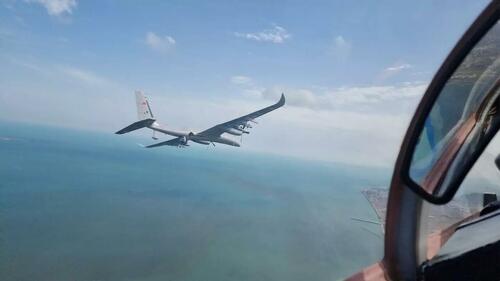
Как Иран использовал турецкий беспилотник, чтобы найти вертолет Раиси
Ближний Восток глазами
Турецкий высотный беспилотник с большой выносливостью сыграл центральную роль в поиске вертолета, на котором в воскресенье вечером находились президент Ирана Эбрахим Раиси и его делегация.
В воскресенье вечером иранские поисково-спасательные службы сообщили, что вертолет совершил «жесткую посадку» в иранской провинции Восточный Азербайджан. Тем не менее, прогресс был скрыт в течение нескольких часов из-за погодных условий, включая туман и дождь. Министр транспорта Турции Абдулкадир Уралоглу присудил еще один комплексный фактор: Вертолет либо не имел своего транспондера, либо сразу же забрал его..
 Беспилотник Akinci, замеченный с азербайджанского МиГ-29, AFP/handout
Беспилотник Akinci, замеченный с азербайджанского МиГ-29, AFP/handout«Мы отслеживаем каждый воздушный сигнал, поскольку Иран является частью района, на который мы реагируем в поисково-спасательных операциях», - сказал Уралоглу турецким СМИ в понедельник. Но мы не смогли получить никакого сигнала. Должно быть, оно было получено, но этого не произошло». По мере того, как поиски нарастали и оказались настолько сложными, Тегеран обратился к Анкаре за помощью.
Тегеран запросил поисково-спасательный вертолет ночного видения и техническую помощь. Об этом сообщает турецкий дипломатический источник Middle East Eye. Впоследствии министр обороны Турции объявил, что выделил Akinci высотный, долговечный дрон Помощь в поисках.
Турецкие источники в сфере безопасности заявили, что министр обороны предложил разместить Акинчи в этом районе даже без официального запроса иранских властей, которые быстро приняли предложение. Источники сообщили, что Акинчи взлетел с авиабазы беспилотников на востоке Турции Бэтмен в 11.18 вечера.
Модель Akinci, выпускаемая турецким производителем беспилотников Baykar с 2019 года, может летать на высоте до 40 000 футов и восстанавливать воздушное пространство в течение более 24 часов.
У Акинджи есть капиталы для работать в условиях жесткой местности и туманной погоды благодаря своей высотной лётной способности и тепловым технологиям.Об этом сообщил источник в оборонной промышленности. «Это очень хороший матч в этом смысле. "
Беспилотник, который способен развивать скорость до 400 км/ч и эффективно сканировать землю на более низких скоростях, пересек иранскую границу из турецкого города Ван, прибыв в Иран в 12:45 утра в понедельник. Источники в министерстве обороны заявили, что беспилотник смог работать, когда все другие самолеты были на земле из-за плохой погоды.
Когда Akinci сообщил о своей миссии по выживанию, турецкое общественное информационное агентство Anadolu запустило прямую трансляцию на X, официально известном как Twitter. Показаны кадры с дрона. Поток привлекает 3,1 миллиона просмотров на своем пике.
В 2:22 утра Акинчи сообщил о своем первом источнике тепла, постоянно делясь изображением с иранскими чиновниками.. Спасатели смогли только Добраться до обломков в 5.46 утра.
Беспилотник Тюркие Akinci был самым просматриваемым самолетом в мире, поскольку он ограничивал иранские лыжи, ища сбитый вертолет, который перевозил президента Ирана Раиси pic.twitter.com / nllPwqEdYK
— TRT World (@trtworld) 20 мая 2024 г.
Семья источников, принимавших участие в операции Akinci, сообщила MEE, что место крушения было близко к району, где беспилотник неоднократно выжил в течение ночи. Координаты, предложенные Akinci, были близки к месту крушения, добавил источник.
По мере улучшения погодных условий Акинчи вернулся в Турцию, прибыв около 6 утра. Древесина дрона имеет полумесяц и звезду над озером Ван на радаре полета, что символизирует турецкие возможности. В понедельник некоторые отметили, что первоначальный маршрут Акинчи в Иран через Тебриз Судя по всему, речь идет о траектории полета над чувствительными иранскими военными объектами, такими как ракетный полигон Аманда, аэропорт Хой, аэропорт Тебриз и база быстрого реагирования иранской армии..
Тайлер Дерден
Mon, 05/20/2024 - 13:40


![Hamas zwrócił kolejne ciała zakładników. Izrael miał otworzyć ogień w Strefie Gazy [RELACJA]](https://cdn.wiadomosci.onet.pl/1/vZsk9lBaHR0cHM6Ly9vY2RuLmV1L3B1bHNjbXMvTURBXy9hOTgxYzNiMjdiZjUyNTY3ZWZlZjBjNzViNWU5NjIxNS5qcGeSlQMAzM_NDmzNCByTBc0JYM0GQN4AAqEwB6ExBA)

